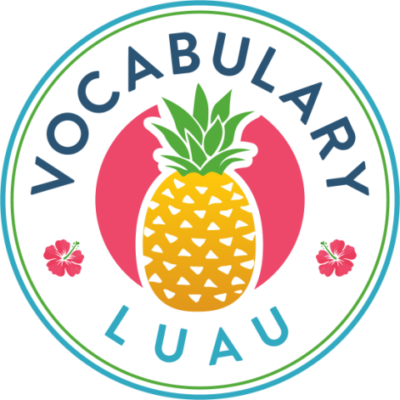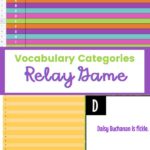In this activity, teams of students race to fill in words and phrases starting with a letter of the alphabet (in order!) relating to a set category.
If the topic is “standing for what’s right,” responses could look like:
A – Antigone
B – be honest
C – care about your integrity
I love relay races because they’re active and they build classroom community.
This one is particularly great because it can be used for concepts as well as terms.
While it’s a relay, it can be done virtually as well.
In this article, I’ll share how to play as a whole class in person, how to play in small groups, and how to play in a virtual environment.
I’m also going to give you a link where you can join in the fun and grab all of my response sheets, both digital and printable versions! For free!
I’ve adapted this from an idea I first got from Sarah Ressler. I feel like my teaching superpower is finding other people’s great ideas and adjusting them!
? How to play the vocabulary relay game
I’m sharing loads of ideas, so get ready!
Choosing a topic
Prior to play, the teacher should choose the topic that students will explore.
Like the Frayer Model, it works well for abstract concepts that might otherwise be difficult to explain or practice.
The topic does not need to be a single word. It can be a phrase or even a sentence.
While it’s terrific when working on specific vocabulary words, it also works really well as a general review activity, with or without the vocabulary.
You know I’m all about the vocabulary, but I’m the first to admit that lots of games and activities have multiple uses. This is one of those!
Here are some examples in different content areas:
Art:
- Color and the color wheel
- Elements of art around us
ELA:
This is a go-to activity for language arts because any story’s theme makes a perfect concept to use.
You can use any of the common themes (good v. evil, the role of love, having courage, the destructive power of revenge, the importance of friendship, etc.).
You can also look at ELA-specific ideas, such as:
- Examples of literary elements
- Characters we love to hate
- Words that are hard to spell
- Words we love
Math:
- Equality
- Measurement
- Angles
- Shapes
- Out of balance
Music:
- Harmony
- Songs we love
- Musical elements
- Instruments and sounds they make
PE:
- Sports/athletes we love/hate
- Game rules
- Showing sportsmanship
Science:
- Living v. non-living
- Cause and effect
- Organization (Periodic Table, animal classification, etc.)
- Systems
- Models
- Variation
Social Studies:
- Democracy
- Role of government
- Landforms
- Geographic oddities
- People, places, and things
Students can choose topics, just make sure they don’t get too caught up in it and spend all of the time you’d allotted for the game deciding on a topic!
? Playing Category Relay
Once you’ve got a topic, you’re ready to play. I’ve divided the instructions by the group size of the students.
While the steps are very similar, I’ve listed them for each variation so you can use the one you want without looking back or ahead at the other groupings.
? How to play Category Relay as a whole class
I love playing this version the first time we play.
It teaches the game through playing it, and students often like it the best of all the versions.
It has a unique power to build classroom community.
For this version, you’ll need a way to call on students (this is not necessary in the other versions).
So whether you use an app, popsicle sticks with names on them, or some other method, have it handy.
To play:
- On a whiteboard/chalkboard, chart paper, or on a piece of paper under a document camera, list the letters of the alphabet in A-Z order.
- Tell the students the topic.
- If you’re working with a specific vocabulary list, tell students to get that list handy.
- Explain the rules of the game:
- We’re going to write a word or a phrase of no longer than five words related to the topic next to each letter. (Tell them if it needs to include a vocabulary word from the list.)
- We have to fill in the lines in A-Z order. No skipping around the alphabet!
- We’re going to time ourselves to see how long it takes us.
- Play begins!
- The teacher calls on a student to fill in the word or phrase. That student runs up and fills in the word.
- After writing the word, the student runs back to their seat.
- The teacher calls on the next student, who races to the list and fills in the “B” line.
- When the list is complete, the teacher should decide if he/she rejects any of the terms. If so, you can allow the class to replace it or you can give the class their score (number of reasonable responses) without allowing substitutions.
For this version, I like to do a debrief where we discuss our responses. This is the most valuable part of the entire game, really.
Also, I track the time it took us, and the next time we play we try to beat our record.
You’ll see space to record time on the printable for the whole class version.

? How to play Category Relay as a class in teams
Once we’ve played as a class, students are ready to play in teams as a class.
This version doesn’t require you to choose students, but it does require making space in the classroom, which is the drawback.
In my classroom(s), space has always been a premium because I somehow always end up in teaching in a classroom that looks like it’s made for hobbits and other small creatures, rather than humans.
And while it’s difficult and takes time, trust me, it’s the most fun and exciting version of the game.
Here’s how to play as teams:
- Assign students to teams of 3 – 5.
- On a whiteboard/chalkboard or chart paper on the wall, list the letters of the alphabet, A-Z. You’ll need one list for each team. You can have them all be on the same board, but you should make it easy to see which list goes with which team.
- Tell students the topic.
- If you’re having students working with a specific vocabulary list, have them get that list ready.
- Explain the rules of the game:
- You will write a word or a phrase of no longer than five words related to the topic next to each letter. (Tell them if it needs to include a vocabulary word from the list.)
- The lines must be filled in A-Z order. No skipping around the alphabet!
- The first group to complete the entire list with reasonable words and phrases wins.
- Play begins!
- In their groups, students should line up single file.
- When the teacher calls “go,” the first student in each group runs to the group’s list (on the board or on paper) and fills in the “A” line with a word or phrase.
- After writing the word, the student runs back to their group and tags the next student, who races to the list and fills in the “B” line. (Remind students to be thinking about what they’ll write when it’s their turn while they wait!)
- Teams should not stop even when one team finishes because the answers need to be verified (next two steps).
- When the teams have filled in all of the letters, the teacher checks the list of the fastest team by reading them out to the class. The class can vote that a word or phrase is not acceptable and reject it.
- If the fastest team misses one or has it rejected, the teacher then checks the second-fastest team’s list in the same way. If the second-fastest team beats the fastest team in acceptable responses, they win.
? How to play Vocabulary Category Relay in small groups
The third method is similar to the one above in that students are divided into teams.
This version has the advantage of being less intense than the Teams method, but it’s also got a lot less energy.
It’s a trade-off.
To play as small groups
- Assign students to groups of 3 – 5.
- Give each team a copy of a response sheet with letters from A – Z and space to write. (You can use the template or the digital form you can access below if you like.)
- You’ll need one list for each team.
- Tell students the topic.
- If you’re having students working with a specific vocabulary list, have them get that list ready.
- Explain the rules of the game:
- You will write a word or a phrase of no longer than five words related to the topic next to each letter. (Tell them if it needs to include a vocabulary word from the list.)
- The lines must be filled in A-Z order. No skipping around the alphabet!
- CHOOSE: You can play in the same way as the Teams method where the first group to complete the entire list with reasonable words and phrases wins. OR You can play for a set period of time. The second method is less intense, so it’s just a matter of the feeling you’re going for.
- Play begins!
- In their groups, should come up with reasonable responses to each letter. They need not go in order. They just try to get them all filled in.
- I ask students to each write in a different color and make me a key so I can see who did what. (Javier = green pen, D’Quan = blue pen, Sherice = black pen)
- When the teams have filled in all of the letters (or time is up), the teacher checks the lists by reading them out to the class. The class can vote that a word or phrase is not acceptable and reject it. It works best to collect all of the lists and line them up and read each letter, so all of the A’s, all of the B’s, etc.
- Give each team a “+” score, based on how many reasonable responses they gave. If they gave 23, then they get a +23. You can either reward them as a team, or you can try to get a certain score as a class by totaling all of the scores.
? How to play Category Relay as individual students
Like the small groups method, this one is calmer, with no running. That’s both good and bad, as I mentioned. There’s so much energy in the room when the kids are racing around!
However, this version is great to get a feel for what the students know individually.
To play as individuals
Give each student a copy of a response sheet with letters from A – Z and space to write. (You can use the template or the digital form you can access below if you like.)
Tell students the topic.
If you’re having students working with a specific vocabulary list, have them get that list ready.
Explain the rules of the game:
You will write a word or a phrase of no longer than five words related to the topic next to each letter. (Tell them if it needs to include a vocabulary word from the list.)
The lines can be filled in any order.
CHOOSE: You can play in the same way as the Teams method where the first person to complete the entire list with reasonable words and phrases wins. OR You can play for a set period of time. The second method is less intense, so it’s just a matter of the feeling you’re going for. I rarely place in a racing mode as groups or individuals, but if your students like that, it’s an option.
Play begins!
Students should come up with reasonable responses to each letter. They need not go in order. They just try to get them all filled in.
When the students have filled in all of the letters (or time is up), you have a few options.
Have students trade papers with another student and check for reasonable responses. (I sometimes have students turn them in so I can see them. It’s time-consuming, but it gives me insight).
Each student gets one point per reasonable response.
? Playing Vocabulary Category Relay in a virtual environment
This game lends itself quite well to a distance learning scenario. There are a couple of ways this can work.
Virtual Method #1: (whole class)
The simplest way is to play following the Whole Class method where the teacher calls on individual students and the form is filled out by the teacher.
If you use the digital form (you can download it at the end of the article), you can share your screen as you add in the responses.
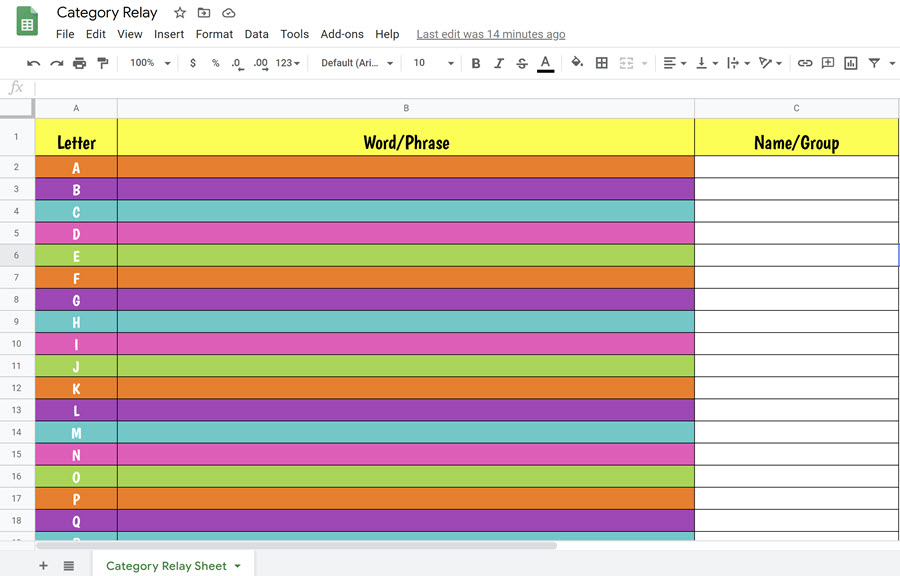
Virtual Method #2 (groups)
Divide students into groups (if you’re in Zoom or similar, you can assign them through that platform) and have them complete the online sheet.
Share one sheet per group. There is a space for them to type in who contributed what responses.
Virtual Method #3 (individual)
Use the Google Sheet I’ve created (or make your own) and push it out to students through your learning management system (such as Google Classroom). Have each student complete it independently.
OR
Have each student fill in an assigned letter in a single Sheet (so they’re all working together.
OR
Use the Google Slide deck and have each student complete one slide with their word or phrase.
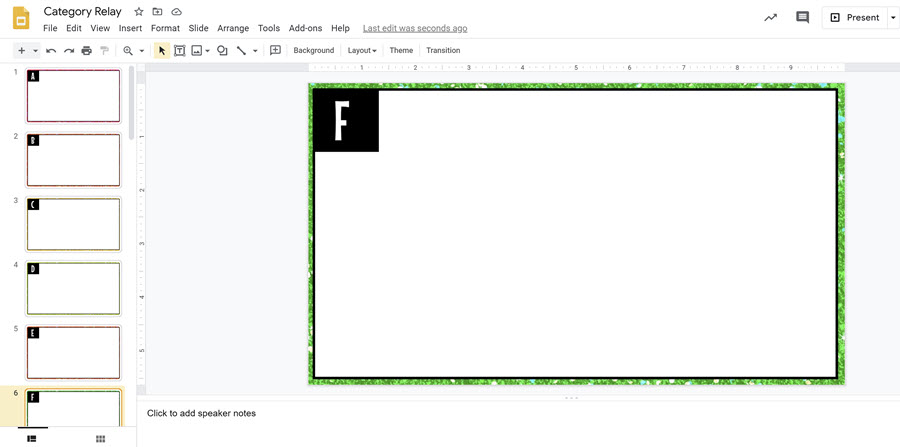
Depending upon the number of students in the class, you may need to assign some students more than one letter, leave some off, or have two students both do the same letter.
Virtual Method #4 (whole class – teams)
Make a Google Slidedeck (or grab the one I created below) and have each team work together to add one idea for each letter of the alphabet using a text box.
If appropriate, they could also insert a photo. For example, if the word they wanted was “Bunsen burner,” they could insert a picture of one.
If they insert an image, they need to insert a text box and label it with their group number so I can tell who did it.
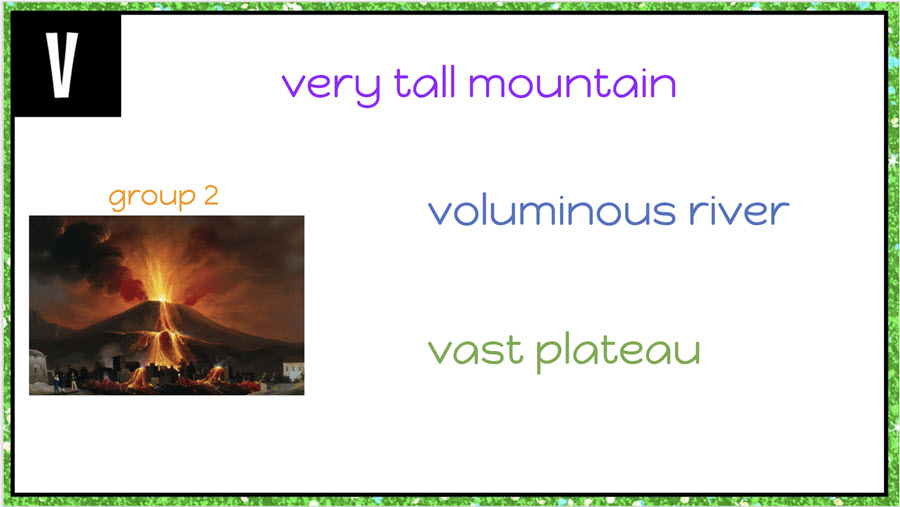
It’s fine with me if they search for “adjectives that start with ‘q’” or similar. Who am I to argue with research?
I assign each team a color to write their text in so I can tell the response that belongs to that team.
I do not allow the same word/phrase to be used by more than one team.
If you like, you could push each slide out to different students and have them each do their own slide and then compile them into a deck.
Okay, that’s all of the versions of the game I play!
?Thinking of words and phrases to use
Let students know that they don’t need to be extremely literal. It’s fine to take their thinking broader.
This is especially helpful with odd letters such as “x,” but it’s important for all of the letters.
To do this, I allow students to use antonyms, synonyms, or other related words to make the connections. (“opposite of patient”, “cetacean synonym” or “friendly is the opposite/antonym”).
They can also use examples from their lives or their learning. (“sister’s boyfriend is egregiously malodorous”).
Adjectives or adverbs that begin with the target letter can be placed in front of the word/phrase (“seafoam green” or “amazing love” or “unbelievable prowess”). There’s an example of this below (“devastatingly sardonic”).
I don’t allow students to just choose a noun and follow it with “is.” So, no “Allen is _______”, filling in the blank with a word in the target letter. That’s too easy.
I do allow them to use names to make phrases if they’re in the context of what we’re studying (so characters or historical figures or places we’re learning).
Here’s an example from my class with the category “Character traits in The Great Gatsby”:
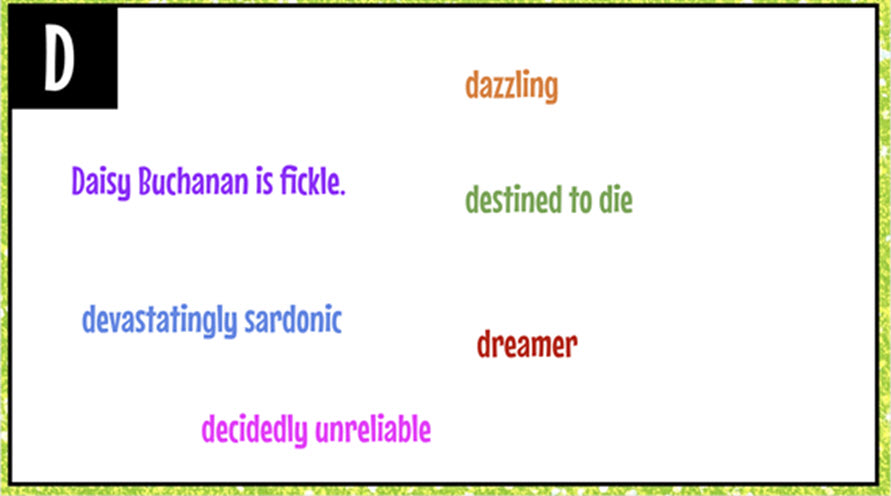
In this example, the target letter is “D.” You can see the different ways groups approached this letter.
I do not let the team use that word again. For example, the group that wrote “decidedly unreliable” cannot use “unreliable” for the letter “U.”
Pro Tip: You can use this particular prompt (characteristics of _____) as a deeper activity by having students guess what character (or animal or element or historical figure…) the group meant by the term/phrase.
? Notes on scoring
I allow teacher override of class rejection of a group’s term to prevent mutiny. I do this because sometimes a response is valid and reasonable, but it’s too esoteric for the class to get it.
Also, sometimes Survivor-like alliances form, and I need to thwart that dynamic!
If a response is rejected, allow them to try to persuade you as to the appropriateness of their response. That will sometimes reveal the best thinking of the entire game.
? Prizes
You can give prizes if you like. I sometimes do and sometimes don’t.
Common prizes I give include:
- Bonus points to use on a quiz or test
- Homework pass
- Late-work pass
- Non-sweet treat (my students love snack-sized bags of cereal)
- A fake trophy I got at the thrift store that has a Post-it with the team name on it
? Variations:
In addition to group size, there are some other variations and modifications you can make in this game.
You can give students some brainstorming time before play when playing the small group method.
You can allow a “Who Wants to Be a Millionaire” kind of mode where they are allowed these lifelines:
- “Phone a friend” to request help
- “Jump the question” and skip a letter. The letter they skip then has to be done by the next student on their team.
I’ve also created a lifeline for this game where students can replace a letter and repeat another letter in its place. So, they could take out “H” and add a second “S,” for example.
I typically recommend only going over two teams’ answers in the interest of time, but you can go over all of the teams’ answers and give awards. Some we’ve used include:
- The word or phrase most likely to be used on a test
- The word or phrase most likely to be used by the teacher
- The word or phrase you’d hear on a tv show
- The one we wish we’d thought of
- The one that made us go, “Huh?”
- The inside joke award (the word or phrase that only makes sense to us and wouldn’t make sense to anyone outside of class)
? Student Support and Accommodation
If a student has a mobility issue, accommodate this by having them have a “designated runner” or let them dictate their answer to you.
For students who need support, give them a heads up on the topic and let them have time prior to play to think of terms. I recommend doing this the day before.
? Differentiation
For high ability learners, I differentiate this activity by:
- Ability grouping them when playing in small groups. I don’t do this when playing the teams competitive version.
- Give them additional constraints, such as:
- Making them have every word in the phrase start with the target letter (except articles – “a” & “the”)
- Add in a requirement about the form the vocabulary word needs to be in – all adjective forms, for example.
? Why the game is effective
Ever since I read about this game, I’ve loved it. There’s so much energy in it (when played as a real relay), but it’s also so incredibly flexible.
Very few games have so many iterations.
I also love, love, love how low-prep it is. Once you’ve got the response sheets, you’re pretty much done. (And I made them for you!)
When you’re using it with a vocabulary list (which is what I do because I’m all about the words!), it’s a great way for students to make multiple connections with the target words and think of them in lots of ways.
This is the kind of thinking we know leads to lasting and valuable acquisition.
? Downloads!
As I’ve mentioned, I’m sharing the response sheets I use.
Join in on the luau and get your free printable and digital response sheets.
You’ll get:
Printable sheets for the different variations described in color and black and white.

The Google Sheet version:

The Google Slide version:

Grab your response sheets here.
? Wrapping Up:
I hope you’ll love this game as much as I do, and I hope your students find it useful and fun.
When we use different variations of the game, we can keep learning fresh.
You may find that your students strongly prefer one version or adaptation over another, and that’s fine.
Feel free to do whatever works for you. You may find another variation that works even better!?
? You May Also Like:
If you like this game, you may also like these vocabulary games:
